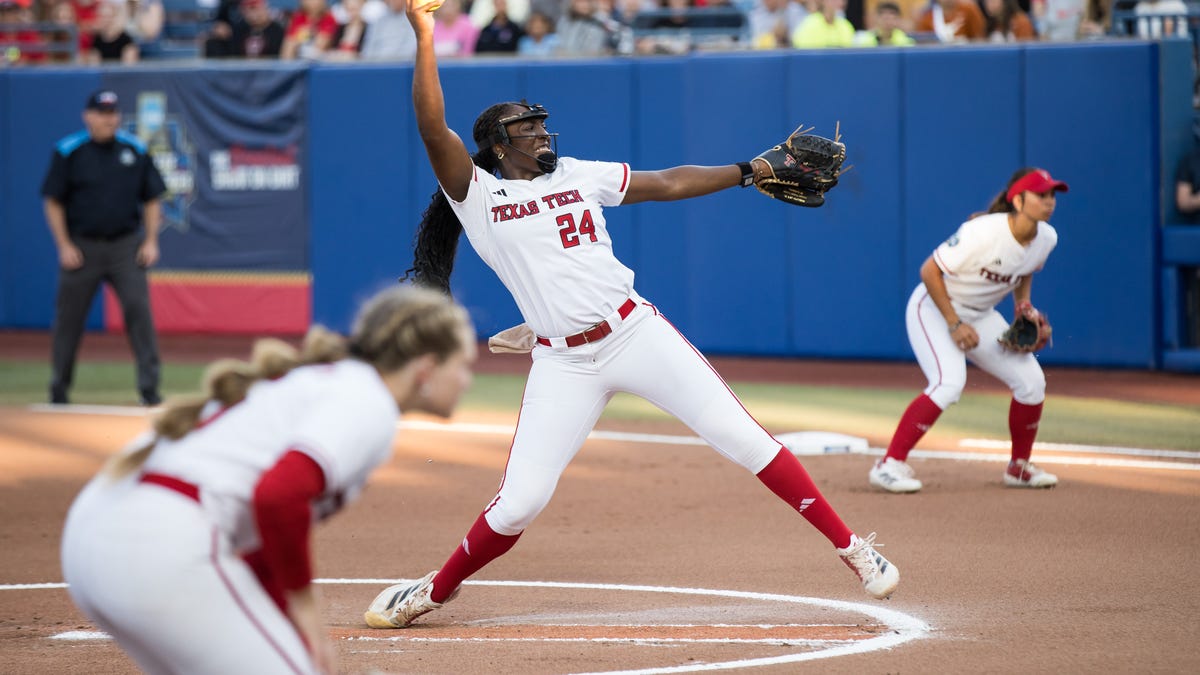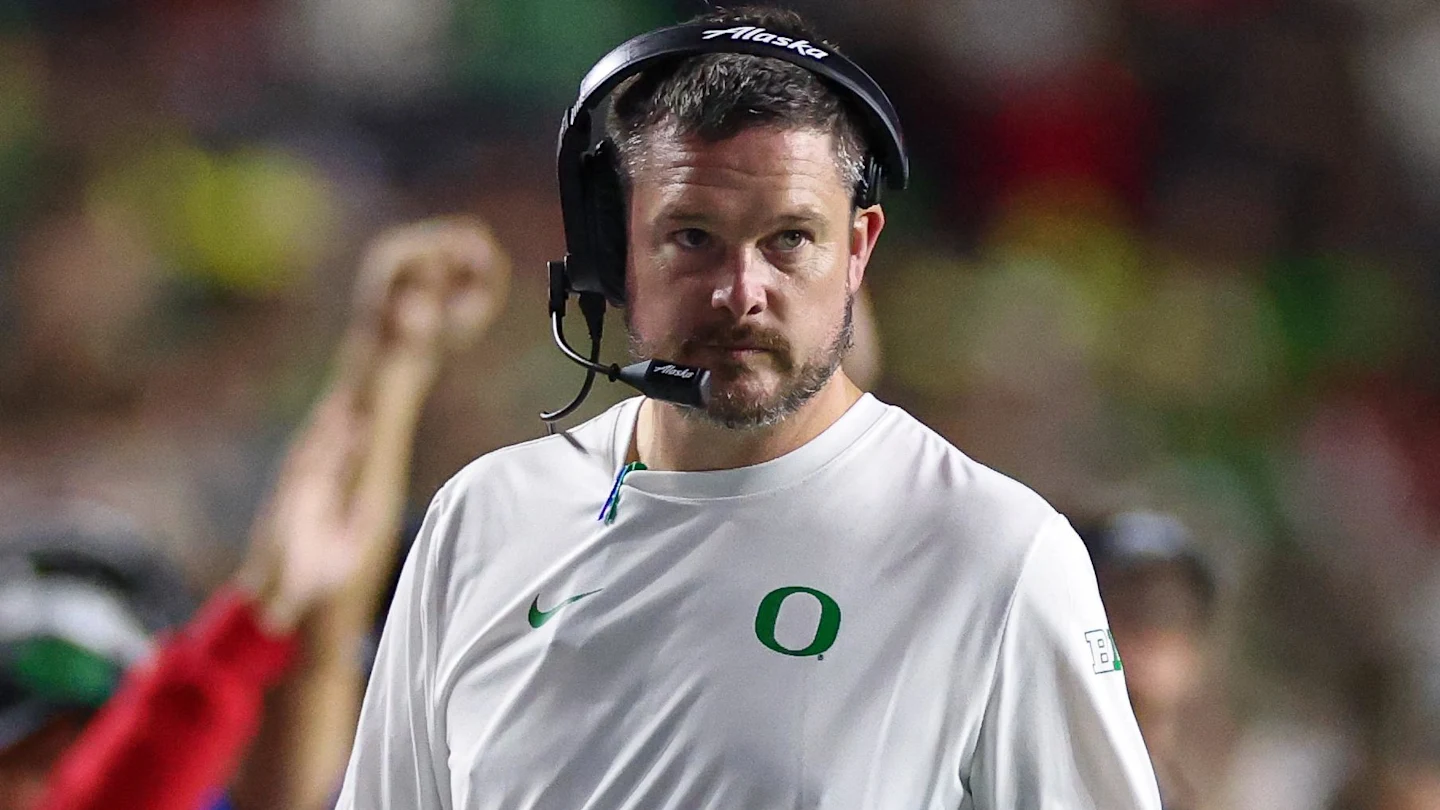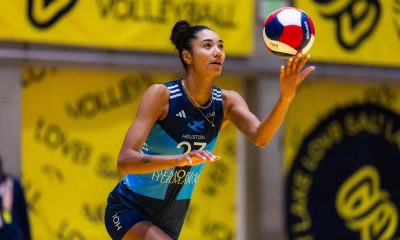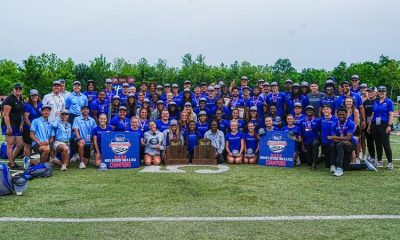NIL
Career-worst night for NiJaree Canady in Texas Tech softball’s WCWS loss to Texas


Why Texas Tech, Texas will win 2025 WCWS
It’s a Lone Star State Women’s College World Series this year, and reporter Jenni Carlson breaks down one reason Texas Tech will win and one reason Texas will win the WCWS.
OKLAHOMA CITY — The final game of the 2025 season was one to forget for NiJaree Canady in the Texas Tech softball team’s Game 3 loss to Texas in the championship of the Women’s College World Series.
Canady went to the circle for the third straight day against the Longhorns and got roughed up from the jump. Texas plated five runs in the bottom of the first and cruised to a 10-4 win to claim the national championship.
Canady had been stellar all season but the Longhorns were on her out the gate on Friday at Devon Park. She got through the first inning but not before surrendering five runs (all earned) on five hits and two strikeouts.
It was just the second time in Canady’s career she allowed five earned runs, the first coming back in the 2024 Super Regionals against LSU.
Canady struck out swinging in her only plate appearance of the night. She was relieved in the circle by Chloe Riassetto and at the plate by Raegan Jennings.
Earlier on Friday, it was reported that Canady had signed another seven-figure name, image and likeness deal with The Matador Club to return to Texas Tech next season.
NIL
Dan Lanning Reveals Reasoning Behind His Loyalty to Oregon

Dan Lanning has been asked many times since 2022 if he’d leave the Oregon Ducks for another head coaching job. While rumors have swirled pertaining to college football openings, a position in the NFL is something that could’ve lured Lanning away from Eugene in the past.
But the Ducks’ coach revealed on The Inner Circle Podcast that his former aspiration of coaching at the professional level is old news.
Dan Lanning Remains Committed to Oregon

Lanning spoke about how he started writing his career goals on his mirror when he was at Arizona State.
“I still put my goals on my mirror,” he said. “No. 1 best father on staff, best husband on staff, man of integrity, Christian, five recruits.”
Lanning, who was a graduate assistant for the Sun Devils, wanted to become a full-time employee. He checked that off the list by getting hired as the on campus recruiting coordinator.

“My next goal on there was head coach, 35. I thought that was really important to me,” Lanning said. “Well, I became the head coach at Oregon at 35. Next goal on there is NFL coach. That ain’t on my goal board no more. It’s off my board. It’ll never be up there again like that.”
Oregon hired Lanning as its football head coach on December 11, 2021, after he won as National Championship as the Georgia Bulldogs defensive coordinator. He’s quickly made a name for himself as one of the top young college football coaches.

Despite Lanning’s name getting thrown around as a candidate for vacancies like Alabama in 2024 or LSU in 2025, he’s remained vocal that Eugene is where he wants to be.
“I truly believe this will be my last job,” Lanning said. “The secret to that is I gotta win. Now do I coach as long as Nick Saban did? I don’t know about that.”
MORE: Weather Concerns Begin For Oregon’s Playoff Game vs. James Madison
MORE: Three Reasons Why Oregon Could Be The Most Dangerous Playoff Team
MORE: Oregon Ducks Projected to Make Program History In 2026 NFL Draft
SIGN UP FOR OUR NEWSLETTER HERE!
Dan Lanning Opens Up About Finishing His Career at Oregon
Staying with the Ducks seems to have additional meaning for Lanning beyond just his loyalty to the program. He said his family plays a major role in why he wouldn’t take an NFL job.
“It used to be a dream, but dreams can change,” Lanning said. “When we took this job, two of my kids had lived in eight states. And you realize, dang, like is that fair to them?”
“So, we took this job, I made a promise to my kids that you’re going to graduate from the same high school. You’re going to graduate from the same middle school,” he continued. “Like, those things are way more important to me than getting the opportunity to coach in the NFL.”

Lanning coached at six different schools from 2011 to 2021 before taking the job at Oregon. He’s coached the Ducks to a second consecutive College Football Playoff this season.
No Oregon head coach has spent more than five full seasons with the program since Mike Bellotti coached from 1995 to 2008. Lanning can change that in 2026.
NIL
Adidas releases tribute to Indiana QB Fernando Mendoza after winning Heisman Trophy

As Fernando Mendoza put the finishing touches on a Heisman Trophy-winning season, he signed an NIL deal with adidas. Shortly after he won college football’s highest honor, the brand paid tribute.
Adidas released a video honoring Mendoza after he won the Heisman on Saturday night. The brand paid homage to his viral quote following the Big Ten Championship when the IU quarterback told FOX Sports’ Jenny Taft, “The Hoosiers are flippin’ champs.”
SUBSCRIBE to the On3 NIL and Sports Business Newsletter
Throughout the year, Mendoza not only became one of the biggest stars on the field, but one of the top names in the sport. He has a $2.6 million On3 NIL Valuation as Indiana soon prepares for the College Football Playoff as the No. 1 seed.
Just before IU took on Ohio State in Indianapolis, Mendoza announced his high-profile NIL deal with adidas. He is the latest college football star to partner with the Three Stripes, joining Ohio State receiver Jeremiah Smith and Nebraska quarterback Dylan Raiola, among others.
“Excited to share that I’ve accepted an opportunity to join adidas!” Mendoza wrote in a LinkedIn post. “I’m very grateful for everyone who has supported me along the way and excited to bring my passion for sport, leadership, and work ethic to the Three Stripes. Let’s get to work.”
More on Fernando Mendoza’s Heisman season
Mendoza led the nation with 33 touchdown passes this year while completing 71.5% of his passes for 2,980 yards, to just six interceptions. Additionally, his $2.6 million On3 NIL Valuation ranks No. 5 in college football and No. 7 in the On3 NIL 100, the first of its kind and defacto NIL ranking of the top 100 high school and college athletes ranked by their On3 NIL Valuation.
Fernando Mendoza beat out Vanderbilt quarterback Diego Pavia for the award, garnering 643 first-place votes and 2,362 points. Pavia got 189 first-place votes and 1,435 points. It’s the latest chapter in a special season for the former Cal star, who helped lead Indiana to its first outright Big Ten title since 1945.
After the announcement, Mendoza delivered a passionate speech. As he wrapped, he had a message for young athletes who think they’re not getting enough attention or are ranked high enough.
“The truth is, you don’t need the most stars, hype or rankings,” Mendoza said. “You just need discipline, heart and people who believe in you. And you need to believe in your own abilities. I hope this moment shows you that chasing your dreams are worth it, no matter how big or impossible they seem.”
NIL
Charles Barkley on NIL, transfer portal: ‘You should not have the ability to get a better offer every year’

NBA legend Charles Barkley has not been shy about his thoughts on NIL and the transfer portal. During Saturday’s Kentucky vs. Indiana broadcast, he candidly discussed the landscape again.
Barkley called the game on ESPN alongside Dick Vitale, the first of two games they will work together. Vitale called for “stability” in college basketball – and college sports as a whole – because of the amount of player movement via the portal. He used Indiana as an example since new coach Darian DeVries virtually built the program from scratch.
Advertisement
SUBSCRIBE to the On3 NIL and Sports Business Newsletter
While Barkley acknowledged he’s in favor of athletes making money through NIL, he also called out players staying more than their four years of eligibility. In addition, he disagreed with the idea of athletes being allowed to seek better offers after every season.
“No. 1, I’m not opposed to players getting paid,” Barkley said on the broadcast. “I always want my players to get treated fairly. But I can’t remember the last time I heard the word, COVID. Some of these guys have been in college for six or seven years. If you’re in college for six or seven years, your name better be, ‘Dr. Somebody.’ You should not still be playing college basketball after six or seven years.
“But you should not have the ability to get a better offer every year. That’s not fair to any school that you are affiliated with because I can’t even do that. None of us can do that, take a better – Amazon, anybody or FOX Sports can come and say, ‘Well, we’ll give you more money and you can leave after every year.’ That’s not fair. … We’ve got to put some guardrails on these sports.”
Advertisement
One of the other new parts of the college basketball landscape is G-League players seeking eligibility. The NCAA has changed its approach regarding players who played in the G-League, arguing they were not professional athletes in a way the old rule said. Instead, if those players are within five years of their high school graduation, they could become eligible unless they went through the NBA Draft process or signed an NBA contract.
To Charles Barkley, that’s another area that needs fixing. He does not think former G-League players should be able to play college basketball.
“We’ve got guys playing in the G-League coming back to college sports now,” he said. “I don’t think that’s fair.”
NIL
Charles Barkley sends strong message after historic college football program’s CFP snub

Hall of Famer and ESPN basketball analyst Charles Barkley has an opinion on most everything, and that includes the College Football Playoff committee’s decision to leave 10-2 Notre Dame off of the 12-team bracket.
Barkley and ESPN college basketball analyst Dick Vitale discussed the Fighting Irish’s CFP snub while calling the Indiana-Kentucky game on Saturday night.
“I was disappointed, but you could see it coming in the last couple polls,” Barkley said. “They were creeping up on Miami. And my biggest problem with the whole thing, everybody’s talked about head-to-head. First of all, that was in August.
“They were very close games [against] A&M and at Miami, but your team is not the same in August as it is in December. Notre Dame is playing as well as anybody in the country other than Indiana and probably Ohio State. And I don’t want to leave out the [Georgia] Bulldogs. Kirby Smart, that man can really coach.”

Notre Dame’s exclusion from the bracket after winning its final 10 games all by double-digit margins and being ranked ahead of Miami (10-2) in every CFP poll until the final one, even though neither the Irish nor Hurricanes played in that final week before the bracket was set, will go down as one of the biggest playoff controversies.
Ultimately, it came down to Miami’s 27-24 home win over Notre Dame in Week 1, a field goal with 1:04 remaining.
Miami supporters clamored and complained all along that the Hurricanes should have been ranked ahead of the Irish, given the same record, well before the final bracket was set. But the teams’ seasons went very different directions after that Week 1 meeting.
Notre Dame lost its first two games by a combined four points, including a 41-40 Week 2 loss to Texas A&M (another CFP team), before reeling off those 10 straight wins, most in dominant fashion.
Miami lost twice in a three-game span to unranked Louisville and SMU before regrouping and finishing strong.
The first CFP rankings came out after that second loss, with Miami landing at No. 18 and Notre Dame at No. 10. Because the teams weren’t close in their overall ranking, the head-to-head result didn’t factor in at the time, and that remained the CFP committee’s explanation even as the teams moved closer and closer in the rankings.
Ultimately, they were two spots apart at No. 10/12, separated by BYU, entering last weekend, when the Cougars got blown out by Texas Tech, essentially forcing the committee to consider Notre Dame and Miami side by side. Others have suggested that both teams deserved to be in over 10-3 Alabama, which lost 28-7 to Georgia in the SEC championship game.
Notre Dame has not taken the snub well and declined to participate in a bowl game as a result.
No. 10-seed Miami will play at No. 7 Texas A&M in the first round of the playoffs on Dec. 20.
NIL
President Donald Trump calls NIL a ‘disaster’ for college athletics, Olympics

President Trump this weekend noted the “current state of NIL is simply not sustainable and could cause serious damage to college athletics, and even the Olympics.” Trump during an event hosting members of the 1980 Miracle on Ice team said, “I think that it’s a disaster for college sports. I think it’s a disaster for the Olympics.” Trump: “The colleges are cutting a lot of their — they would call them sort of the ‘lesser’ sports, and they’re losing them like at numbers nobody can believe. They were really training grounds, beautiful training grounds, hard-working, wonderful young people.” Trump added, “A lot of these sports that were training so well would win gold medals because of it. Those sports don’t exist, because they’re putting all their money into football.” Trump: “Colleges cannot afford to be paying the kind of salaries that you’re hearing about” (OUTKICK, 12/13). Trump said of overhauling NIL in college sports, “Something ought to be done, and I’m willing to put the federal government behind it. And if it’s not done fast, you’re going to wipe out colleges” (USA TODAY, 12/12).
NIL
ESPN FPI has 2 teams tied as College Football Playoff favorites

If you can’t pick one favorite, maybe it’s wise to pick two. That certainly seems to be the logical play with ESPN, as their FPI rankings give two teams an even chance to win the national title– even beyond the tenth of a percent. FPI is a slightly controversial prediction index that ties past performance into a mathematical attempt to predict future results.
Throughout the 2025 season, ESPN not only ranked the teams, but forecast their chance to win their respectives leagues, to earn a CFP berth, and even to win the CFP title. But heading into the opening week of CFP play, two teams are in exactly the same shape on top of ESPN’s ranking of most likely teams to win the national title.
FPI’s title favorites
Both Ohio State and Indiana are given a 25.9% chance to win the CFP title. Interestingly, Ohio State is slightly more likely to reach the title game, in ESPN’s reckoning (a 45% chance for the Buckeyes against a 43.1% chance for Indiana). The two are massive co-favorites, as ESPN’s third team in terms of title likelihood is Georgia, with an 11.6% shot at winning the title.
The Remainder of the CFP field
The only other teams with a better than 10% chance at the championship are Texas Tech and Oregon. The Red Raiders are rated at a 10.9% chance to win the title. The Ducks are rated with a 10.3% chance to grab the title.
No team outside of those five has a greater than 4.8% chance at winning the title– with that particular figure being linked to Ole Miss’s title chances. ESPN’s computers certainly don’t think well of the two Group of Five teams, as ESPN gives both Tulane and James Madison a 0.1% chance at winning the CFP crown. James Madison is rated with an 0.5% chance of reaching the title game, while Tulane’s chance is 0.4%.
Confusion reigns about FPI’s ratings
The math-related details behind the CFP can be complicated. 6-6 Penn State is still FPI’s No. 17 team in the nation, while 5-7 Auburn is No. 26. FPI also greatly appreciated Notre Dame, ranking the Irish third nationally. That’s comfortably ahead of the Miami and Alabama teams that grabbed the last CFP spots instead of the Irish (Miami ranks seventh and Notre Dame eighth at all. But when it comes to title chances, the FPI is all in on two teams in an exactly equal measure.

-

 Rec Sports3 weeks ago
Rec Sports3 weeks agoFargo girl, 13, dies after collapsing during school basketball game – Grand Forks Herald
-

 Motorsports3 weeks ago
Motorsports3 weeks agoCPG Brands Like Allegra Are Betting on F1 for the First Time
-

 Sports3 weeks ago
Sports3 weeks agoTwo Pro Volleyball Leagues Serve Up Plans for Minnesota Teams
-

 Sports3 weeks ago
Sports3 weeks agoUtah State Announces 2025-26 Indoor Track & Field Schedule
-

 Sports3 weeks ago
Sports3 weeks agoSycamores unveil 2026 track and field schedule
-

 Motorsports2 weeks ago
Motorsports2 weeks agoJo Shimoda Undergoes Back Surgery
-

 Motorsports2 weeks ago
Motorsports2 weeks agoRedemption Means First Pro Stock World Championship for Dallas Glenn
-

 Sports3 weeks ago
Sports3 weeks agoTexas volleyball vs Kentucky game score: Live SEC tournament updates
-

 Rec Sports2 weeks ago
Rec Sports2 weeks agoRobert “Bobby” Lewis Hardin, 56
-

 Rec Sports2 weeks ago
Rec Sports2 weeks agoHow this startup (and a KC sports icon) turned young players into card-carrying legends overnight























